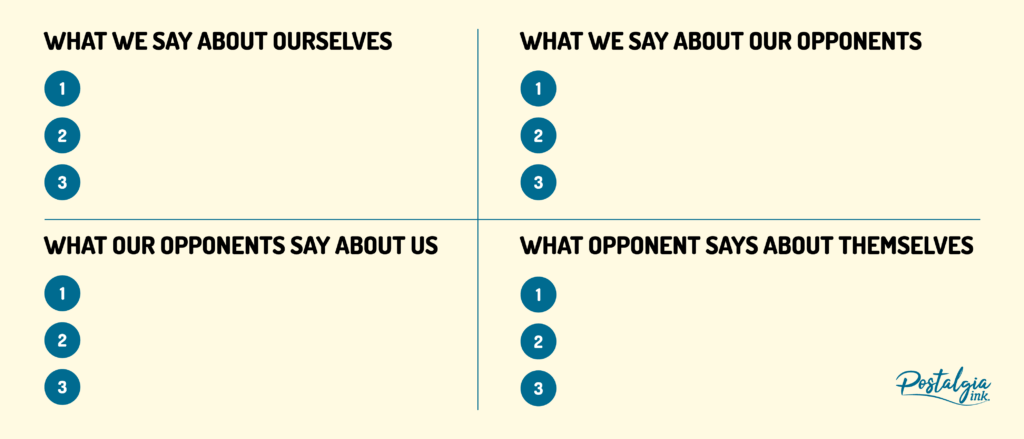How to Write an Effective Voter Persuasion Letter
By: Ilan Mann
July 31, 2024Introduction
Winning an election – be it a primary or a general election – in today’s sophisticated campaigning environment requires more planning, resources, and multifaceted execution than ever before. Even elections for local offices are subject to fierce competition by motivated candidates and savvy campaign teams marshaling extraordinary resources to get voters to cast a ballot for them on election day.
Direct Mail is a crucial part of any campaign, and has a massive impact on voter behavior. Along with canvassing, phone banking, literature dropping, appearances at events, and earned and paid media (both digital and traditional), direct mail is one of the core channels through which to reach voters.
Article Highlights
Why is Direct Mail Effective for GOTV?
How to Craft a Persuasive Message
Why is Direct Mail Effective for GOTV?
The core functions of any political campaign are threefold: Identify supporters, persuade accessible and undecided voters, and get voters out to the campaign.
Campaigns identify supporters in order to ensure that their efforts to get voters to the polls on election day are not wasted – or worse, counterproductive – driving out undecided or unsupportive voters. But what happens when there aren’t enough supporters to win?
Most campaigns start with a number in mind: a “votes to win” number. This is the number of votes that the campaign thinks they need to comfortably win. In several scenarios, however, the candidate will start the campaign without having the requisite number of votes to win and no clear path to get there without winning over a lot of undecided voters. This is especially likely in local or state-level races, or even primaries for higher office, where the candidate is an unknown commodity. It is also common when the candidate cannot rely on partisan support, such as if they are running for local office as an independent, or if they’re running in a primary against their fellow partisans from the same party.
In these cases, the candidate and their campaign team need to persuade voters, and direct mail is one of the best ways to do that. That’s true for a number of reason: The written format allows candidates to clearly communicate their message in longer-form, in a way that other forms of media don’t. Also, direct mail does not depend on your voter being at home when it is delivered, in the way that a phone call or a knock on their door does. Direct mail can be sent at scale, and so doesn’t require precious human resources to reach thousands of voters at once. Finally, unlike putting up a billboard or carpeting a district with printed literature, direct mail can be targeted, so that you’re not wasting resources sending a persuasion message to voters who are already voting for you (like your mom), or would never vote for you (like your opponent’s mom).
For all of the above reasons, direct mail is also an extremely powerful tool for getting out the vote (GOTV), but for the purposes of this blog we will focus on how to craft an effective persuasion letter for political campaigns.
Only Persuade the Persuadable
As alluded to above, one of the advantages of direct mail is that it can be targeted to specific voters. The first and arguably most important key to crafting an effective piece of persuasive direct mail is to focus on persuading the persuadable. Ideally you want to reach out to people who are likely open to supporting you, while leaving out the people whose support you already know you can count on.
Excluding the latter group should be easy, as if you can count on someone’s support, you ought to have their name on a list somewhere. Building a list of people who are likely to support you but don’t necessarily support you yet is a bit trickier.
Of course, the easiest way to find out if someone is likely to support you is to ask them. While campaign volunteers are canvassing and phone-banking, they will run into thousands of people who will say that they are undecided. These people are a good base for a persuasion list, as they have heard of your candidate, and have expressed that they are neither currently supportive nor opposed, but asking some further probing questions can significantly augment the quality of your data and build a more effective list. Who are they voting for at other levels (state, local, federal, presidential)? What issues concern them most? Who have they voted for in the past?
Of course, you may choose to mail all of these undecided voters, but campaigns are fundamentally about the application of scarce resources towards the goal of winning on election day. You will need to make tough choices – do we pay for that extra radio ad, or do we mail an extra 700 people? Should we mail 10,000 people once, or 5,000 people twice? When making difficult decisions like that, the richness of your data will pay off. You will also be able to use it to improve the quality of your message, which will be discussed shortly hereafter in this blog.
Another effective method for building your list is to look at historical voter data – to the extent that you have it. Some campaigns will inherit more data about voters past preferences than others. Have they voted for candidates like yours in the past? Have they expressed positions on issues in past elections that your campaign champions in this election.
Another important consideration when building a list is whether these voters have voted in past elections. If they have a spotty record of voting, research shows that they are much less likely to actually show up to vote for you or any candidate on election day. Rank these voters lower on your list. You may still decide to mail them, resources permitting, but at least your campaign will be armed with the data it needs to make intelligent decisions and properly steward your limited resources for maximum effect.
Rank and Segment
To that point, when building your list of accessible and undecided (in other words: persuadable) voters, you should be applying all sorts of tags and labels to the data that you collect, so that you can later break up your larger list of persuadable voters into different segments. The more granular the data you collect, the more flexibility you will have to use your list effectively.
For example, you may speak to a voter at the door, and learn that they care about lowering taxes on small businesses (and agree with your candidate), are concerned about the rate of illegal immigration (and disagree with your candidate), and vote for candidates similar to yours at the congressional and state level, but are undecided as to whether they will vote for your candidate. You may then learn, from past voter data, that they have only voted in one of the last three elections.
You would then apply a score to this and all other persuadable voters that you speak with, based on the internal considerations of your campaign. You may decide to rank this person relatively low, because they are unlikely to vote at all, and have some policy disagreements with your candidate. This ranking exercise allows you to decide to not mail voters like this one, and to use your limited human and financial resources to work twice as hard on other voters, and to save your GOTV budget, as you will not be driving this voter out to the polls.
But maybe your campaign is flush with cash, or short on persuadable voters (as can happen especially in smaller races), and you decide that you will mail this person. Because of your segmentation efforts, you know that you should not talk to this person about immigration, and should focus on small business taxes. You may decide to send a small business tax-focused piece of direct mail to this voter and a thousand other persuadable voters who expressed agreement with your campaign on that issue. It is very likely that this voter – who like all voters is paying limited attention to politics and is inundated with messages from candidates and groups at all levels – will never even discover your disagreement on the issue of immigration, and will decide to vote for you based on their strong agreement on the issue of small business taxes.
Now imagine if you had just decided to send every persuadable voter a hard-hitting direct mail piece about immigration. You would have – if anything – persuaded this voter to vote against you on election day instead of staying home.
With the power of variable messaging, you can effortlessly swap in different terms – or even entire paragraphs – based on who is receiving the letter. To one voter you could write “I am running because I care about climate change” while to another voter you could write “I am running because I care about reforming the justice system.” Both may be equally true, but focusing on one or the other better tailors your message to specific segments on your list of persuadable voters.
Postalgia empowers you to effortlessly swap in variables in your printed message or your handwritten message – or even the images that you use – to better tailor your message to the voter who is receiving it.
How to Craft a Persuasive Message
Once you have considered how best to target your message to different audiences and segments within your list, the next step is to craft a persuasive message. The difference between a persuasive letter and something that fails to capture the attention of the voter comes down to a few principles.
The first is that – wherever possible – your letter should tell a story. Humans are a story-telling species, and are evolutionarily hard-wired to use stories to learn, to communicate complex ideas, and to transfer information in a way that is easily understood and remembered.
That’s one of the reasons that we have witnessed an explosion in content across multimedia platforms in the last few decades. Our desire for story-based entertainment is seemingly insatiable. Think about some of the most valuable companies of the last 20 years – Netflix, Meta (Facebook & Instagram), Twitter – companies that deliver stories to us as expediently as possible. Do you ever lie awake at night endlessly scrolling through short videos or tweets, unable to stop? That’s your brain giving you a steady drip of dopamine as a reward for consuming stories.
To the extent that you can phrase your message as a story, your letter will be more effective. Consider the following two messages:
- “50% of high-paying, stable manufacturing jobs have left our district since 1995 because of globalization and outsourcing. I’m running to bring those jobs back.”
- When I graduated high school in 1995, it was still possible for me and my friends to get a job in manufacturing in our district, and that’s exactly what dozens of my friends did. Today, half of those jobs don’t exist anymore, which means those friends had to start over – some of them lost their houses when they were unable to pay their mortgages, some of them turned to substance abuse. We talk a lot of about the benefits of outsourcing and globalization, but I’ve been to funerals for people who could still be alive today if our policy-makers had thought more about the downsides – and that’s why I’m running.
Most would agree that the second, story-based message is a lot more compelling and engaging than the dry, statistical approach in the first message. It’s also a lot longer, and there is lots of debate about whether a long letter or a short letter is more effective.
Conventional wisdom in politics is that it’s a lot harder to be concise than it is to write a long message. Mark Twain put it best when he wrote “ I didn’t have time to write a short letter, so I wrote a long one instead.” Voters have short attention spans, the theory goes, and so the message needs to be punchy and short.
On the other hand, there have been multiple studies run by non-profit foundations showing that longer letters get more donations. Is that only true for a captive audience of donors who are on-board with the cause? Or could it apply to persuasion letters to undecided voters as well?
The answer takes us back to first principles: the better story is the more captivating message, whether it’s long or short. 103 million people sat through the 30-minute long “Kony 2012” video, once called the most viral video of all time, and many of those people skip past 30-second ticktocks halfway through.
A story doesn’t have to be long to be captivating. Consider the famous 6-word story (probably incorrectly) attributed to Ernest Hemingway: “For sale: Baby shoes, never worn.” In 6 words, the author manages to convey more captivating emotion than many 200-page novels do.
So wherever possible, when crafting a persuasive letter, show rather than tell. Similarly, personify dry data points.
“If you divide the public debt by the number of voters in this district, each voter owes over $20,000 of public debt” seems abstract.
“When my grandson opened his eyes for the first time, he’d already inherited over $20,000 of public debt” is just as short and punchy, but it’s a lot more compelling.
Use a message grid to figure out what you want to say, and then figure out how to translate those key messages into a story that the voter will want to read.
Using a Political Message Grid
A message grid (sometimes called a message box or message square or message matrix) is a simple 2 x 2 grid that helps you plot out your messaging.
It looks like this:

Ideally, you want to craft your story in such a way that what your opponent says about themselves and what they say about you reinforce what you are saying about them and yourself respectively. The less tension between the two narratives, the more your opponent’s narrative is actually reinforcing yours.
For example, in the 2004 presidential election, John Kerry described himself as a thoughtful, cerebral decision maker, and his opponent (President Bush) as a rash simpleton. Bush’s narrative was that Kerry was an indecisive flip-flopper (the line between thoughtful and indecisive is rather thin in politics) while the President described himself as decisive, and a kind of shoot-from-the-hip leader who everyone knows where he stands.
John Kerry trying to describe how he voted for an early version of an appropriations bill before opposing the passage of a later version (“I voted for it before I voted against it”) fit perfectly into the story that Bush was telling, and served as the basis for a series of ads that successfully managed to reinforce the Bush narrative – with help from the Kerry narrative.
Another great (if exaggerated) example of this phenomenon is the Simpsons episode where Bart and Martin run against one another for class president, each declaring that “a vote for Bart is a vote for anarchy.”
Leveraging the Medium of Direct Mail
Finally, remember that design elements can reinforce or undermine your message. If you’re trying to portray your candidate as a down-to-earth everyman, don’t show a picture of them in a $3,000 suit beside their corvette.
Similarly, if you’re trying to portray your candidate as authentic and hard-working, you can’t go wrong using Postalgia to send handwritten letters to constituents. Not only do handwritten envelopes get opened at a higher rate, letters that are handwritten (in whole or in part) communicate effort and earnestness to voters. They captivate their attention and stand out.
Remember that while you’re crafting your letter in a vacuum in which your attention is completely focused on the content, the design, the wording, and the recipient list, your letter will be competing for your voter’s attention with a deluge of other political mail, non-political mail, digital messages from all angles, whatever is on TV, and a hundred other demands on their attention from kids’ soccer practices to a comment from a colleague at work.
Your letter really needs to stand out and be captivating visually as well as in its content. Several ways to achieve that include using an unusual envelope size (an A7 invitation size, for example, can be very effective), and printing in vibrant color on the outer envelope. Avoid windowed envelopes wherever possible, as those have amongst the lowest open rates for standard, printed mail.
Of course, the gold standard for open rates is handwritten envelopes, which Postalgia can produce at scale, to spare your poor campaign interns’ wrists from having to hand-address tens of thousands of envelopes.
Click the link below to talk to a Postalgia direct mail expert to start working on your next persuasion mailer now.




